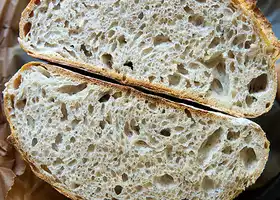Download Stashcook Now. Get the best meal planning app for your family.
Easy Sourdough Bread (Whole Wheat-ish) Recipe

Special equipment: Straight-sided vessel for the bulk fermentation, Dutch oven, flour-sack towel Here's my list of essentials for sourdough bread baking. Digital Scale: Do not attempt this recipe without a scale. This one costs $9. Troubleshooting what goes wrong with sourdough bread is impossible if you've measured with cups. They're simply not accurate. Troubleshooting: If you have issues with your dough being too sticky, please read this post: Why is my sourdough so sticky? The 4 common mistakes. Flour: I prefer making this bread with 350g bread flour and 50g of freshly milled, stone-milled flour, which provides both flavor and color. (Read the post above for more details and why I suggest stone-milled flour as opposed to commercial whole wheat flour.) I've been using a mix of Anson Mills graham flour and rye flour, but there are many great stone-milled flours out there, and you may have a local source, which is even better. 50g may seem like a tiny amount of stone-milled flour for this recipe, but I am constantly amazed by how much flavor this small amount of freshly milled flour adds. If you are new to sourdough baking, I recommend starting with 100% bread flour (King Arthur Flour is my preference) because it's so forgiving and easy to work with. Once you get the hang of it, start incorporating stone-milled flour a little bit at a time. I don't like using more than 100g (25%) of stone-milled flour in this recipe. If you cannot find bread flour — I know supplies are limited at the moment — you can use all-purpose flour. If you live in a humid climate, consider reducing the water by 20 g. You can add the 20 g of water in slowly while you mix until the dough resembles that in the video/photos. Salt: I like breads to be a little bit saltier than standard. If you are sensitive to salt, start with 8g. Next time, adjust salt as you wish.
Ingredients
Method
Email:
hello@stashcook.com© Copyright 2026 Stashbox Ltd. All rights reserved.